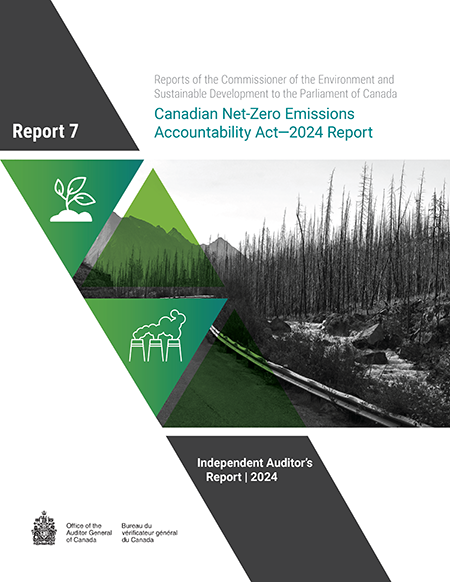2024 Reports 6 to 10 of the Commissioner of the Environment and Sustainable Development to the Parliament of Canada
Report 7—Canadian Net-Zero Emissions Accountability Act—2024 Report
Key facts and findings
- There are 6 years left to achieve the 2030 greenhouse gas emissions target of 40% to 45% below 2005 levels. Emissions data showed that as of 2022, Canada reduced its greenhouse gas emissions by 7.1% (not including land use, land‑use change, and forestry accounting contributions).
- In 2023, the federal government published its first progress report on the 2030 Emissions Reduction Plan under the act, and it reported on 149 measures to support greenhouse gas emissions reductions.
- Of the 20 measures we audited that were being developed or implemented by the federal government, only 9 were on track, 9 were facing challenges, and 2 had significant barriers, such as facing delays in meeting milestones.
- For 41 recommendations from our past audits on climate change, since 2021, we found that federal organizations had undertaken actions to implement 16 recommendations, 22 recommendations were in progress, and 3 had not been implemented.
- With its first progress report on Canada’s 2030 Emissions Reduction Plan, Environment and Climate Change Canada missed opportunities to enhance transparency, such as publishing milestones and timetables for implementing each measure.
Why we did this audit
- Making progress on implementing effective mitigation measures is crucial for Canada to significantly and rapidly reduce its greenhouse gas emissions to avoid the severe effects of climate change, a defining issue of our time.
- It is important to track the federal government’s progress on implementing measures to achieve its emissions targets.
- Recommendations from audit reports aim to address the deficiencies found by our audits that pose significant risk if left uncorrected.
Recommendation
- To improve the timeliness and effectiveness of the implementation of federal climate change measures to reduce emissions, Environment and Climate Change Canada, together with responsible federal organizations, should
- increase the reliability of greenhouse gas emissions reduction estimates for each measure so that budgetary, planning, and delivery decisions are based on better information
- establish a government-wide approach and guidance for value-for-money assessments of emissions reduction measures and publish the value of emissions reductions for individual measures
- collect and report disaggregated data that tracks access to and delivery of measures for the identified groups
Please see the Link opens a PDF file in a new browser windowfull report to read our complete findings, analysis, recommendations and the audited organizations’ responses.
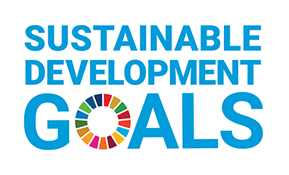

Climate change is a defining issue of our time. Canada and over 190 parties have committed to action through the United Nations’ Paris Agreement, 2030 Agenda for Sustainable Development, and Sustainable Development Goal 13 on urgent action to combat climate change and its impacts. These commitments call on countries to integrate climate change measures into national policies, strategies, and planning (Sustainable Development Goal target 13.2).
Visit our Sustainable Development page to learn more about sustainable development and the Office of the Auditor General of CanadaOAG.
Exhibit highlights
Canada’s greenhouse gas emissions, projections, objective, and target
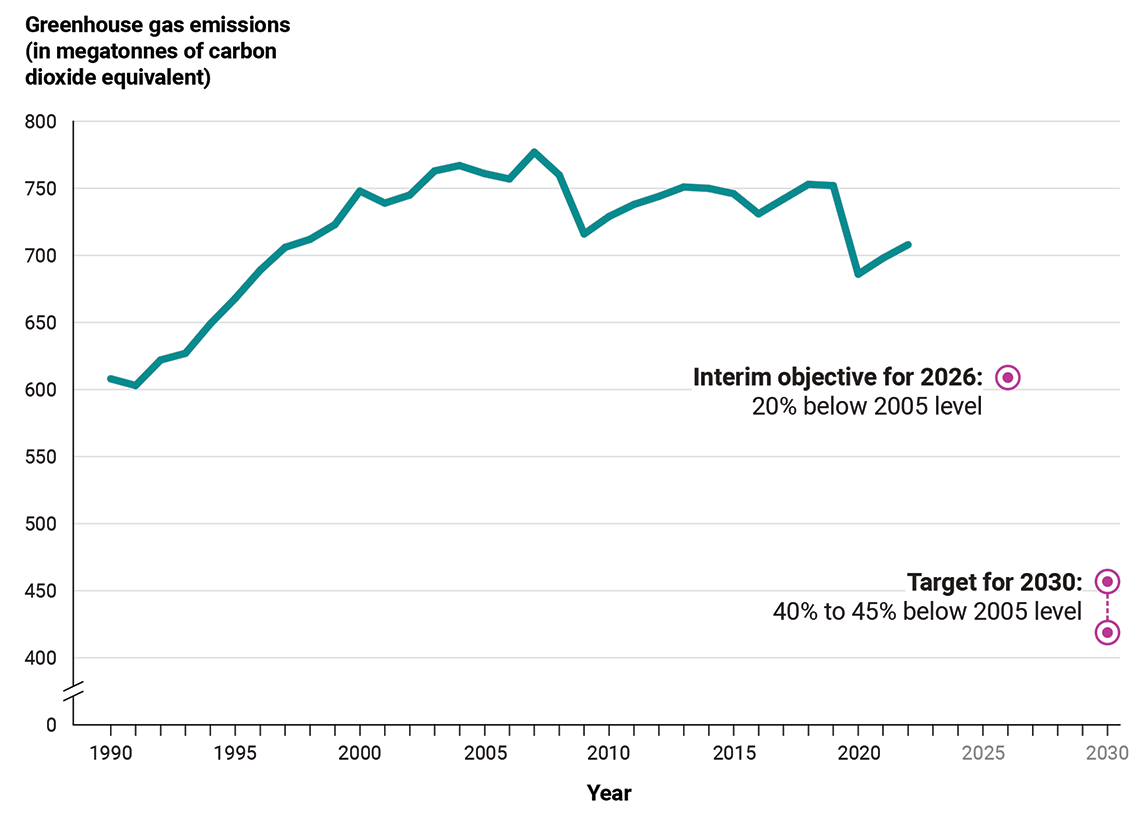
Note: The land use, land-use change, and forestry accounting contributions were not included because those values had not yet been published.
Source: Based on data from the National Inventory Report 1990–2022: Greenhouse Gas Sources and Sinks in Canada, Environment and Climate Change Canada, 2024
Text version
This graph shows Canada’s greenhouse gas emissions from 1990 to 2022. In 2022, Canada’s total greenhouse gas emissions were 708 megatonnes of carbon dioxide equivalent, down from 761 megatonnes in 2005 but up from 608 megatonnes in 1990. The specific amounts from 1990 to 2022 are as follows.
In 1990, Canada’s greenhouse gas emissions were 608 megatonnes of carbon dioxide equivalent. In 1991, emissions fell to 603 megatonnes. In 1992, they rose to 622 megatonnes. In 1993, they rose to 627 megatonnes. In 1994, they rose to 649 megatonnes. In 1995, they rose to 668 megatonnes. In 1996, they rose to 689 megatonnes. In 1997, they rose to 706 megatonnes. In 1998, they rose to 712 megatonnes. In 1999, they rose to 723 megatonnes.
In 2000, emissions rose to 748 megatonnes. In 2001, they fell to 739 megatonnes. In 2002, they rose to 745 megatonnes. In 2003, they rose to 763 megatonnes. In 2004, they rose to 767 megatonnes. In 2005, they fell to 761 megatonnes. In 2006, they fell to 757 megatonnes. In 2007, they rose to 777 megatonnes. In 2008, they fell to 760 megatonnes. In 2009, they fell to 716 megatonnes.
In 2010, emissions rose to 729 megatonnes. In 2011, they rose to 738 megatonnes. In 2012, they rose to 744 megatonnes. In 2013, they rose to 751 megatonnes. In 2014, they fell slightly to 750 megatonnes. In 2015, they fell to 746 megatonnes. In 2016, they fell to 731 megatonnes. In 2017, they rose to 742 megatonnes. In 2018, they rose to 753 megatonnes. In 2019, they fell slightly to 752 megatonnes.
In 2020, emissions fell to 686 megatonnes. In 2021, they rose to 698 megatonnes. Finally, in 2022, they rose to 708 megatonnes.
The graph also shows the interim objective for 2026, which is 20% below the 2005 level. This means that Canada’s greenhouse gas emissions would need to be 609 megatonnes of carbon dioxide equivalent by 2026.
Finally, the graph shows the target for 2030, which is 40% to 45% below the 2005 level. This means that Canada’s greenhouse gas emissions would need to be between 419 and 457 megatonnes of carbon dioxide equivalent by 2030.
Performance of Group of Seven countries in reducing greenhouse gas emissions
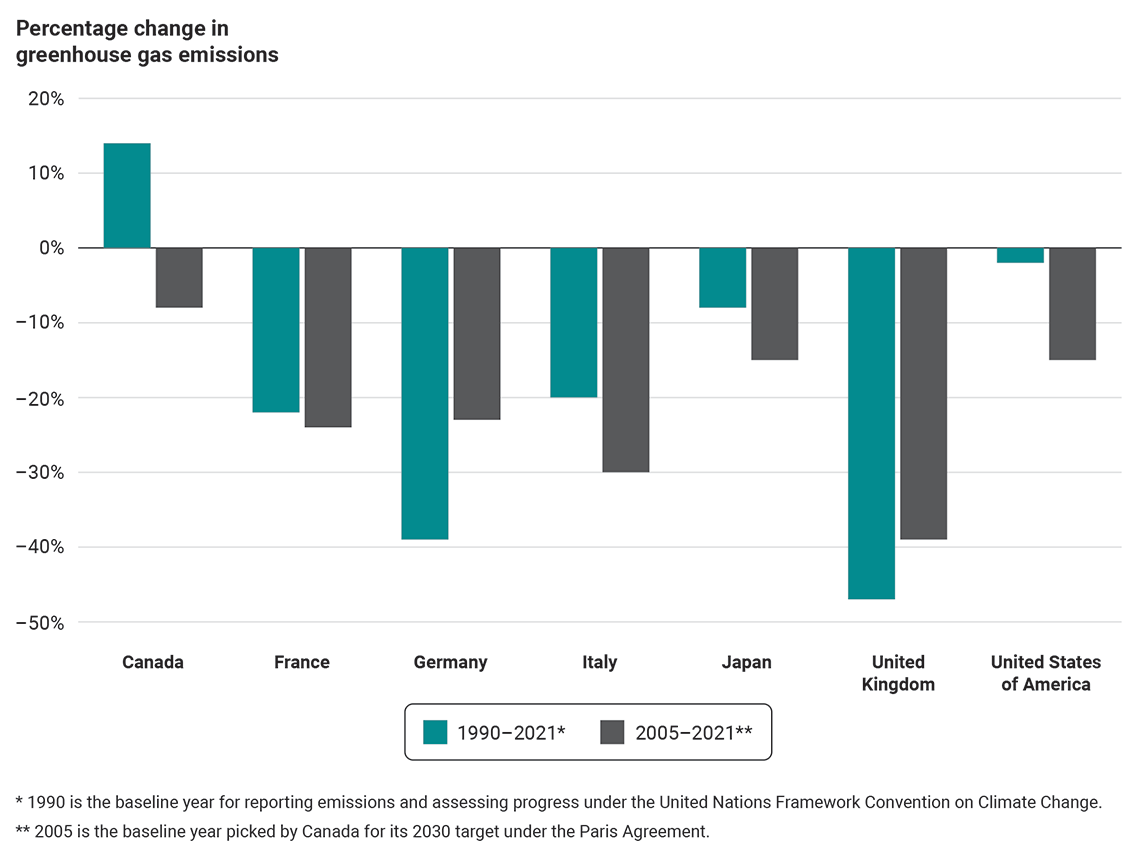
Source: National inventory reports for 1990–2021 for the above countries
Text version
This graph compares Group of Seven countries’ greenhouse gas emissions reductions in 2 periods: 1990 to 2021 and 2005 to 2021. The baseline year for reporting emissions and assessing progress under the United Nations Framework Convention on Climate Change is 1990. The baseline year chosen by Canada for its 2030 target under the Paris Agreement is 2005.
Canada was the worst performer among the Group of Seven countries for both time periods. The percentage changes in greenhouse gas emissions for the 7 countries are as follows.
For Canada, the percentage change was plus 14% from 1990 to 2021 and minus 8% from 2005 to 2021. For France, the percentage change was minus 22% from 1990 to 2021 and minus 24% from 2005 to 2021. For Germany, the percentage change was minus 39% from 1990 to 2021 and minus 23% from 2005 to 2021. For Italy, the percentage change was minus 20% from 1990 to 2021 and minus 30% from 2005 to 2021. For Japan, the percentage change was minus 8% from 1990 to 2021 and minus 15% from 2005 to 2021. For the United Kingdom, the percentage change was minus 47% from 1990 to 2021 and minus 39% from 2005 to 2021. Finally, for the United States of America, the percentage change was minus 2% from 1990 to 2021 and minus 15% from 2005 to 2021.
Federal organizations advanced a variety of measures
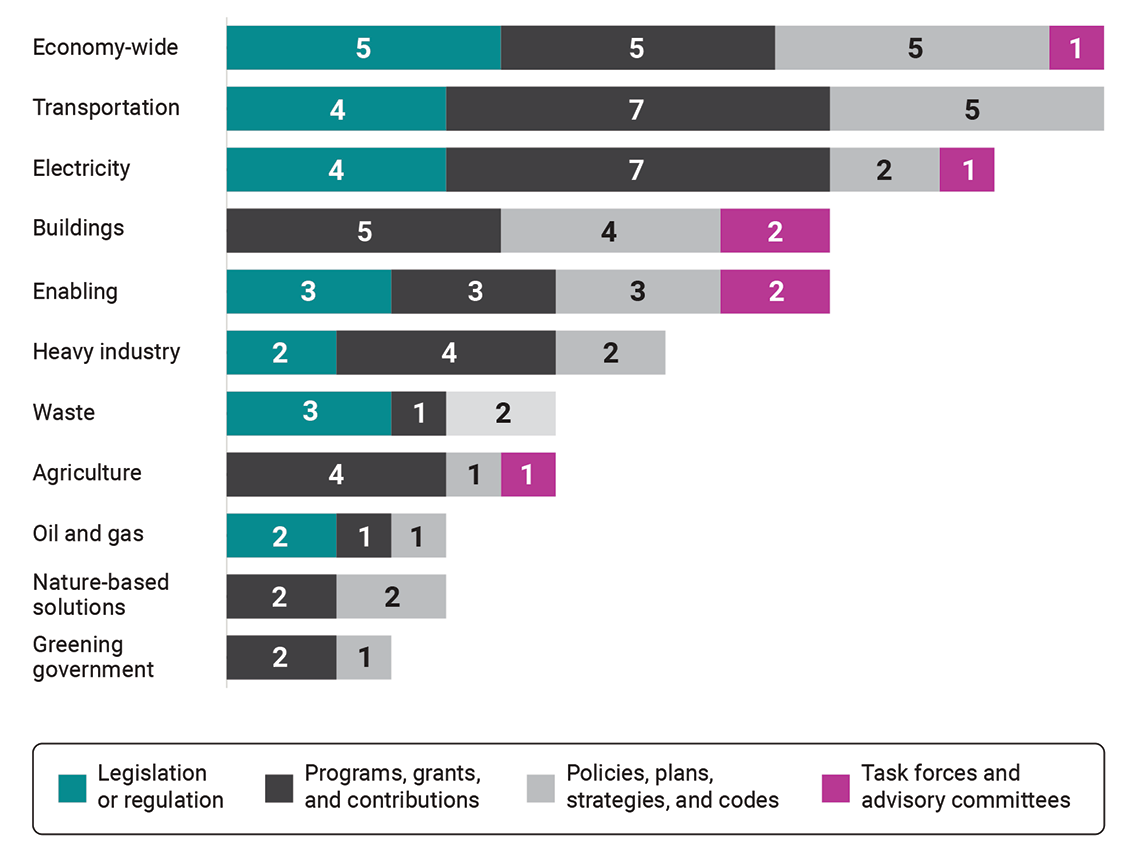
Source: Based on information from the 2023 Progress Report on the 2030 Emissions Reduction Plan, Environment and Climate Change Canada
Text version
This chart shows, in descending order, the number of measures advanced by federal organizations, organized by 11 sectors, as follows.
There were the following 16 economy‑wide measures: 5 pieces of legislation or regulations; 5 programs, grants, and contributions; 5 policies, plans, strategies, and codes; and 1 task force or advisory committee.
In the transportation sector, there were the following 16 measures: 4 pieces of legislation or regulations; 7 programs, grants, and contributions; and 5 policies, plans, strategies, and codes.
In the electricity sector, there were the following 14 measures: 4 pieces of legislation or regulations; 7 programs, grants, and contributions; 2 policies, plans, strategies, and codes; and 1 task force or advisory committee.
In the buildings sector, there were the following 11 measures: 5 programs, grants, and contributions; 4 policies, plans, strategies, and codes; and 2 task forces and advisory committees.
There were 11 enabling measures: 3 pieces of legislation or regulations; 3 programs, grants, and contributions; 3 policies, plans, strategies, and codes; and 2 task forces and advisory committees.
In the heavy industry sector, there were the following 8 measures: 2 pieces of legislation or regulations; 4 programs, grants, and contributions; and 2 policies, plans, strategies, and codes.
In the waste sector, there were the following 6 measures: 3 pieces of legislation or regulations; 1 program, grant, or contribution; and 2 policies, plans, strategies, and codes.
In the agriculture sector, there were the following 6 measures: 4 programs, grants, and contributions; 1 policy, plan, strategy, or code; and 1 task force or advisory committee.
In the oil and gas sector, there were the following 4 measures: 2 pieces of legislation or regulations; 1 program, grant, or contribution; and 1 policy, plan, strategy, or code.
There were the following 4 nature‑based‑solutions measures: 2 programs, grants, and contributions and 2 policies, plans, strategies, and codes.
Finally, there were the following 3 greening‑government measures: 2 programs, grants, and contributions and 1 policy, plan, strategy, or code.
Infographic

Text version
Canadian Net-Zero Emissions Accountability Act—2024 Report
Canada’s limited progress since 2005 to reduce greenhouse gas emissions means that time is running out to achieve the bulk of emission reductions.
The target for 2030 is for Canada’s greenhouse gas emissions to be 40% to 45% below 2005 levels, which means that Canada’s emissions would need to be between 419 and 457 megatonnes by 2030. However, from 2005 to 2022, there was only a 7.1% drop in megatonnes of emissions—that is, from 761 megatonnes in 2005 to 708 megatonnes in 2022. Note: The land use, land‑use change, and forestry sector accounting contributions were not included because those values had not yet been published. Source: Based on data from the National Inventory Report 1990–2022: Greenhouse Gas Sources and Sinks in Canada, Environment and Climate Change Canada, 2024.
What does a megatonne (or 1 million tonnes) of carbon dioxide equivalent represent? One megatonne of carbon dioxide equals 306,364 gas‑powered passenger vehicles driven for 1 year. Source: Greenhouse Gas Equivalencies Calculator, Natural Resources Canada.
This audit looked at 20 greenhouse gas reduction measures by 7 federal organizations. Nine measures were on track, 9 faced challenges, and 2 faced significant barriers.
This audit also looked at how 4 federal organizations advanced 41 recommendations we made in 7 previous climate reports. Sixteen recommendations were implemented, 22 were in progress, and 3 were not implemented.
The stakes grow ever higher each year, and the window of opportunity to reduce emissions and meet the 2030 and 2050 targets is rapidly closing.
ClimateScanner
What is a supreme audit institution?
Supreme audit institutions are independent national authorities responsible for conducting audits of government activities and overseeing the use of public resources.
Our audit work on climate change is contributing to a global project called ClimateScanner, which is an initiative of the International Organization of Supreme Audit Institutions’ Working Group on Environmental Auditing being led by the Supreme Audit Institution of Brazil. The project will provide a global overview of national governmental climate action based on an assessment of information provided by participating national audit offices.
Supreme audit institutions have a unique role to play in addressing the climate crisis. Although they have different mandates, they share a common mission to provide independent assessments of the use of public resources and the performance of public policies. In doing so, they can provide reliable information and contribute to government transparency and policy improvement.
The objectives of this project include assessing national governments’ climate action, consolidating data to provide a global overview, and supporting decisions for future audit work. The results of the assessments will be made available over the next year; until then, preliminary global results and Canada’s 2024 results are available below. The ClimateScanner website (available in English only) provides additional information on the project and its status.
Results of Canada’s assessment
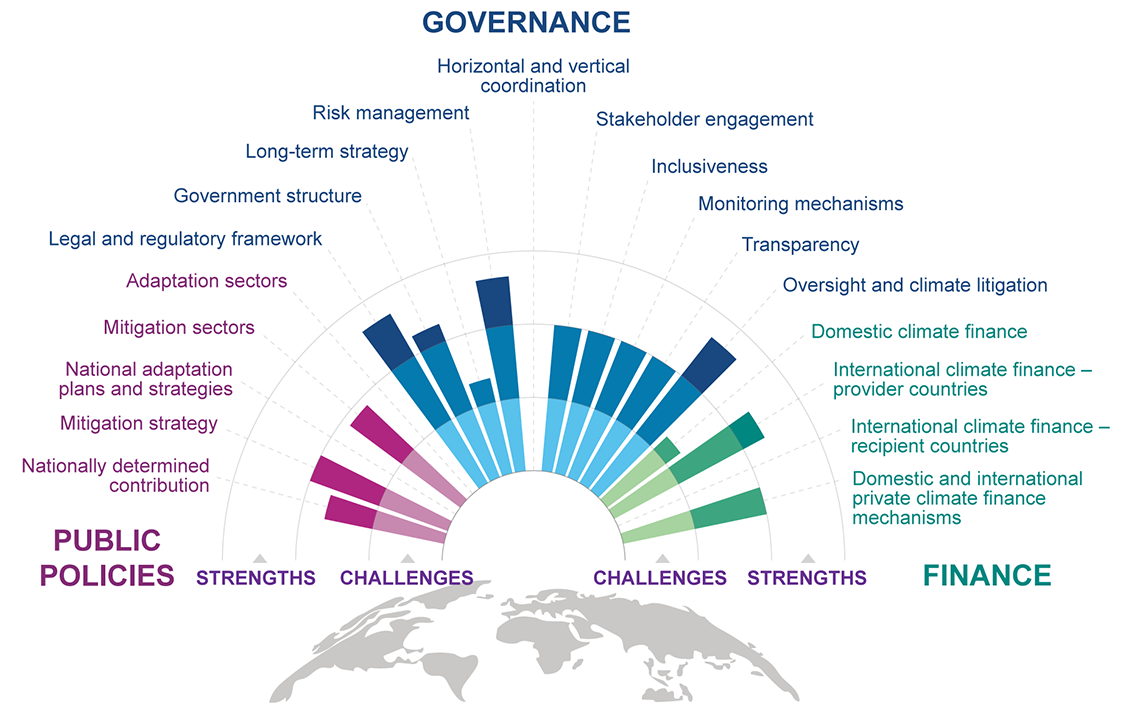
Source: Based on information from the 2023 Progress Report on the 2030 Emissions Reduction Plan, Environment and Climate Change Canada
Text version
This sun graph shows the results of Canada’s assessment of its government’s climate action. The results show 19 criteria grouped under 3 axes. The 3 axes are public policies, governance, and finance.
Under the public policies axis, there are 5 criteria. In descending order, Canada’s strengths in 3 of these criteria are mitigation strategy, mitigation sectors, and Nationally Determined Contribution, or NDC. There are no results yet available for the remaining 2 criteria—that is, national adaptation plans and adaptation sectors.
Under the governance axis, there are 10 criteria. Canada’s greatest strengths are in 3 of these criteria—that is, legal and regulatory framework, oversight and climate litigation, and risk management. Next, Canada has a strength in government structure. Canada was assessed as having achieved intermediate progress in 5 other criteria—that is, inclusiveness, monitoring mechanisms, stakeholder engagement, transparency, and, to a lesser extent, long-term strategy. There is no result for horizontal and vertical coordination.
Under the finance axis, there are 4 criteria. Canada’s strength is in international climate finance as a provider country. In descending order, Canada was assessed as having achieved intermediate progress in 2 other criteria—that is, domestic and international private climate finance mechanisms, and domestic climate finance. The criteria international climate finance as a recipient country was not applicable to Canada.
Related information
Entities
Tabling date
- 7 November 2024
Related audits
- 2023 Report of the Commissioner of the Environment and Sustainable Development
Report 6—Canadian Net-Zero Emissions Accountability Act—2030 Emissions Reduction Plan

